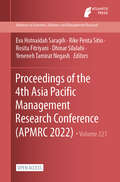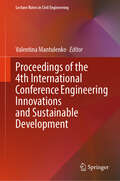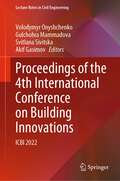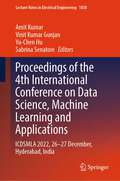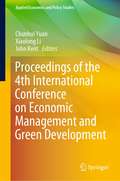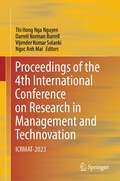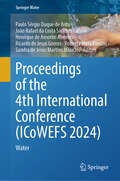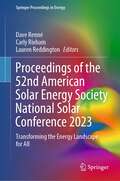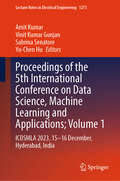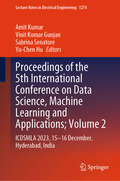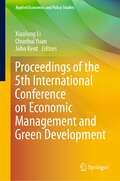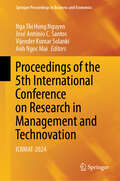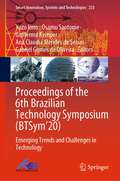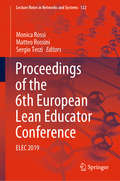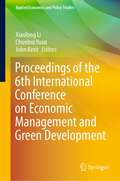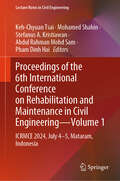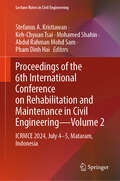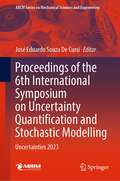- Table View
- List View
Proceedings of the 4th Asia Pacific Management Research Conference (Advances in Economics, Business and Management Research #221)
by Eva Hotnaidah Saragih Rike Penta Sitio Rosita Fitriyani Dhinar Silalahi Yeneneh Tamirat NegashThis is an open access book. It has been our great honor to welcome all the participants to the 4th Asia-Pacific Management Research Conference was held in Surabaya, Indonesia, on May 18th–20th, 2022 as a hybrid conference (virtualy conference). I recalled formulating the concept and conducting this conference with the Research Center and Case Clearing House (RC-CCH) Team back in 2017. The conference encourages fresh and impactful studies that address the latest issues and topics, particularly in economics, management, business, and accounting. The forum particularly welcomes the discussion and sharing among research fellows in a semi-formal academic setting. As we reach the fourth conference, we are confident that we will maintain a contribution to the global literature. It is undeniable that the theme of the COVID-19 Pandemic is the main issue of this fourth conference, but rather than focusing on the misery, we look for models, technologies, and concepts that are beneficial for the economy and businesses to grow toward the new normal. This conference received 136 abstracts, of which 57 were accepted articles in Atlantis Proceeding.
Proceedings of the 4th International Conference Engineering Innovations and Sustainable Development (Lecture Notes in Civil Engineering #648)
by Valentina MantulenkoThis book presents the contributions from the 4th International Conference Engineering Innovations and Sustainable Development, held in Samara, Russia, on February 27, 2025. By presenting international research on various sustainability issues, it includes topics such as current trends in industrial and agricultural development, innovations in the construction and transport sectors, problems concerning the financing of innovative activities and governmental support for innovations, and engineering competences and skills in the era of new technologies. It also covers the economic, environmental, and informational aspects of sustainable development in the context of innovations. Finally, the book addresses theoretical and practical aspects by studying the phenomenon of sustainability and engineering development in terms of comparing international experiences. It provides significant value for scientists, teachers, and students of higher educational institutions, and specialists, who are researching sustainable development issues in the era of engineering innovations.
Proceedings of the 4th International Conference on Building Innovations: ICBI 2022 (Lecture Notes in Civil Engineering #299)
by Volodymyr Onyshchenko Gulchohra Mammadova Svitlana Sivitska Akif GasimovThis book gathers the latest advances, innovations, and applications in the field of building design and construction, by focusing on new design solutions for buildings and new technologies creation for construction, as presented by researchers and engineers at the 4th International Conference Building Innovations (ICBI), held in Poltava – Baku, Ukraine – Azerbaijan, on May 19-20, 2022. It covers highly diverse topics, including structures operation, repairing and thermal modernization in existing buildings and urban planning features, machines and mechanisms for construction, as well as efficient economy and energy conservation issues in construction. The contributions, which were selected by means of a rigorous international peer-review process, highlight numerous exciting ideas that will spur novel research directions and foster multidisciplinary collaborations.
Proceedings of the 4th International Conference on Data Science, Machine Learning and Applications: ICDSMLA 2022, 26–27 December, Hyderabad, India (Lecture Notes in Electrical Engineering #1038)
by Amit Kumar Yu-Chen Hu Vinit Kumar Gunjan Sabrina SenatoreThis book includes peer reviewed articles from the 4th International Conference on Data Science, Machine Learning and Applications, 2022, held at the Hyderabad Institute of Technology & Management on 26-27th December, India. ICDSMLA is one of the most prestigious conferences conceptualized in the field of Data Science & Machine Learning offering in-depth information on the latest developments in Artificial Intelligence, Machine Learning, Soft Computing, Human Computer Interaction, and various data science & machine learning applications. It provides a platform for academicians, scientists, researchers and professionals around the world to showcase broad range of perspectives, practices, and technical expertise in these fields. It offers participants the opportunity to stay informed about the latest developments in data science and machine learning.
Proceedings of the 4th International Conference on Economic Management and Green Development (Applied Economics and Policy Studies)
by Xiaolong Li John Kent Chunhui YuanThe proceedings shed light on selected topics including economic management, public administration, and green development. Featuring scholarly works from the 4th International Conference on Economic Management and Green Development (ICEMGD 2021), this volume of proceedings showcases the papers composed with regard to a diverse range of topics situated at the intersecting field of Economic Management, Public Administration and Green Development. Arising as the top concern of the global community, issues of green development impose challenges for the academia to bridge the interdisciplinary prowess in tackling the gap of knowledge within concerned fields. ICEMGD 2021 is an annual conference initiated by the year of 2017 under the goal of bringing together intellectuals from economics, business management, public administration, and otherwise related spheres for the share of research methods and theoretical breakthroughs. The aim of the proceeding volume is for the integration of social scientific research methods with research into alarming development issues. The ICEMGD 2021 seeks to promote joint initiatives among well-established fields like macro- and microeconomics, international economics, finance, agricultural economics, health economics, business management and marketing strategies, regional development studies, social governance, and sustainable development. Featuring interdisciplinary contributions, this book will be of interest to researchers, academics, professionals and policy makers in the field of economic management, public administration, and development studies.
Proceedings of the 4th International Conference on Research in Management and Technovation: ICRMAT-2023
by Vijender Kumar Solanki Thi Hong Nga Nguyen Darrell Norman Burrell Ngoc Anh MaiThis book brings together selected papers from the Fourth International Conference on Research in Management and Technovation held in Hanoi, Vietnam, in 2023, with a focus on defining action-based plans around innovation and technology as tools for societal and organizational advancement. Today's business and technology intersections are obvious. Cloud-sharing, scheduling, and virtual conference rooms are some of the few examples. Cutting-edge academic researchers use business and technology every day to navigate volatility, uncertainty, complexity, and ambiguity (VUCA) in the environment, make good judgments, stay ahead of the competition, better their marketing tactics, and create new business initiatives. The research highlighted in this book aims to demonstrate how technology empowers managers, strategists, and researchers to make decisions that are data-driven and effective.
Proceedings of the 4th International Conference on the Future of Asean 2023 (Advances in Social Science, Education and Humanities Research #759)
by Mahyudin Ahmad Nursyamilah Annuar Sabiroh Md Sabri Ismalaili Ismail Farah Lina Azizan Nurul Labanihuda Abdull Rahman Nurwahida FuadThis is an open access book.ASEAN countries are diverse, with GDP per capita ranging from about USD1,297 in Myanmar, a lower-middle income country, to USD64,041 in Singapore, a high-income advanced economy (World Economic Outlook Database, IMF, April 2019). ASEAN marked its 50th anniversary in 2017 with relatively successful and prosperous development in five decades, with establishment of the ASEAN Economic Community in 2015 as one the key milestones as well as the achievements of Millennium Development Goals 2015.Building on the past successes via Millennium Development Goals 2015, especially in areas such as poverty eradication, better health outcomes and quality education, ASEAN countries are poised to make a more inclusive progress towards the newly adopted development agenda of Sustainable Development Goals 2030 (SDG 2030), which cover a wider set of interlinked development objectives under its 17 goals.The economic dynamism of the ASEAN region on the back of its strong income growth, continuous structural transformation and infrastructure improvements is expected to support sustainable development in the region. From the IMF Report (September 2018), most ASEAN countries, with their continued income growth and strong policy efforts, are on track to eradicate absolute poverty by 2030, while some of these countries are already doing well in terms of gender equality. Similarly, improvement in universal primary education completion is one of the key progress areas made by the majority of ASEAN countries.Despite these achievements, challenges persist, hence, we need to ensure a more inclusive and environmentally sustainable development in the region. Income inequality remains relatively high in several countries, and the shift towards manufacturing has strained environmental sustainability in the region. Furthermore, the other remaining development challenges call for a more comprehensive and integrated approach via the intra-ASEAN initiatives.
Proceedings of the 4th International Conference: Water (Springer Water)
by João Rafael da Costa Sanches Galvão Paulo Sérgio Duque de Brito Henrique de Amorim Almeida Ricardo de Jesus Gomes Sandra de Jesus Martins Mourato Roberta Mota PanizioThis book publishes some papers presented at the 4th International Conference on Water Energy Food and Sustainability (ICoWEFS 2024), a major forum to foster innovation and exchange knowledge in the water-energy-food nexus. The world is facing unprecedented challenges to mitigate climate change and adapt to its negative impacts, affecting global economy and society. Europe intends to take the lead on the transition to sustainability, as a chief priority of Horizon Europe is a European Green Deal to transform Europe in a climate-neutral continent, fostering disruptive innovation and the deployment of new technologies and innovative solutions, helping creating a sustainable future. Innovation regarding water, energy, agri-food, bio-economy, natural resources and environment will speed up the transition towards sustainability, promoting water and food security in the world. A climate-neutral continent by 2050 will drive technological, economic and societal transformations towards circular economies and green and clean technologies, and the decarbonisation of energy-intensive industries.
Proceedings of the 4th Vocational Education International Conference (Advances in Social Science, Education and Humanities Research #697)
by Achmad Nizar Hidayanto Adhi Kusumastuti Samsudin Anis Sita Nurmasitah Atika Atika Delta Apriyani Taofan Ali Achmadi Sudiyono SudiyonoThis is an open access book. The 4th Vocational Education International Conference (VEIC 2022) is an annual and internationally - refereed conference. The main objective of VEIC 2022 is to provide an international platform for researchers, practitioners, stakeholders in the field of vocational education to discuss about the issue and challenges in the field of Technology and Vocational Education. The main theme of VEIC 2022 is Post-pandemic Challenge in Technical and Vocational Education and Training of Higher Education.
Proceedings of the 52nd American Solar Energy Society National Solar Conference 2023: Transforming the Energy Landscape for All (Springer Proceedings in Energy)
by Carly Rixham Dave Renné Lauren ReddingtonThis book highlights research presented during the American Solar Energy Society’s 52nd National Solar Conference (ASES SOLAR 2023) held at the University of Colorado Boulder. The conference, with the theme of “Transforming the Energy Landscape for All” attracted a broad base of solar and renewable energy professionals and thought leaders, including researchers, architects, engineers, entrepreneurs, installers, manufacturers, economists, finance professionals, and policymakers – providing a platform for the exchange of ideas, information and business insights and unbiased perspectives on progress toward greater sustainability. These conference papers explore best practices and major roadblocks from a variety of perspectives in the transformation towards 100% renewable energy in the United States, focusing on the challenges to advancing renewables through principles of justice, equity, diversity, and inclusion (JEDI).
Proceedings of the 5th International Conference on Construction, Architecture and Technosphere Safety: ICCATS 2021 (Lecture Notes in Civil Engineering #168)
by Andrey A. Radionov Vadim R. Gasiyarov Dmitrii V. Ulrikh Svetlana S. Timofeeva Vladimir N. AlekhinThis book highlights recent findings in civil and environmental engineering and urban planning, and provides an overview of the state of the art in these fields, mainly in Russia and Eastern Europe. A broad range of topics and issues in modern engineering are discussed, including construction, buildings and structures, advanced materials, innovative technology, methods and techniques in civil engineering, heating, gas supply, water supply and sewerage, foundation engineering, BIM, structural reliability, durability and monitoring, special and unique structures construction (bridge, tunnel, road, railway engineering), design and construction of hydraulic structures, concrete engineering, urban regeneration and sustainable development, urban transport system, engineering structure safety and disaster prevention, water resources engineering, water and wastewater treatment, recycling and reuse of wastewater, etc. The volume gathers selected papers from the 5th International Conference on Construction, Architecture and Technosphere Safety (ICCATS), held in Sochi, Russia in September 2021. The authors are experts in various fields of engineering, and all papers have been carefully reviewed.
Proceedings of the 5th International Conference on Data Science, Machine Learning and Applications; Volume 1: ICDSMLA 2023, 15–16 December, Hyderabad, India (Lecture Notes in Electrical Engineering #1273)
by Amit Kumar Yu-Chen Hu Vinit Kumar Gunjan Sabrina SenatoreThis book (Volume 1) includes peer reviewed articles from the 5th International Conference on Data Science, Machine Learning and Applications, 2023, held at the G Narayanamma Institute of Technology and Sciences, Hyderabad on 15-16th December, India. ICDSMLA is one of the most prestigious conferences conceptualized in the field of Data Science & Machine Learning offering in-depth information on the latest developments in Artificial Intelligence, Machine Learning, Soft Computing, Human Computer Interaction, and various data science & machine learning applications. It provides a platform for academicians, scientists, researchers and professionals around the world to showcase broad range of perspectives, practices, and technical expertise in these fields. It offers participants the opportunity to stay informed about the latest developments in data science and machine learning.
Proceedings of the 5th International Conference on Data Science, Machine Learning and Applications; Volume 2: ICDSMLA 2023, 15–16 December, Hyderabad, India (Lecture Notes in Electrical Engineering #1274)
by Amit Kumar Yu-Chen Hu Vinit Kumar Gunjan Sabrina SenatoreThis book includes peer reviewed articles from the 5th International Conference on Data Science, Machine Learning and Applications, 2023, held at the G Narayanamma Institute of Technology and Sciences, Hyderabad on 15-16th December, India. ICDSMLA is one of the most prestigious conferences conceptualized in the field of Data Science & Machine Learning offering in-depth information on the latest developments in Artificial Intelligence, Machine Learning, Soft Computing, Human Computer Interaction, and various data science & machine learning applications. It provides a platform for academicians, scientists, researchers and professionals around the world to showcase broad range of perspectives, practices, and technical expertise in these fields. It offers participants the opportunity to stay informed about the latest developments in data science and machine learning.
Proceedings of the 5th International Conference on Economic Management and Green Development (Applied Economics and Policy Studies)
by Xiaolong Li John Kent Chunhui YuanThe proceedings consist of papers accepted by the 5th ICEMGD, which are carefully selected and reviewed by professional reviewers from corresponding research fields and the editing committee of the conference. The papers have a diverse range of topics situated at the intersecting field of Economic Management, Public Administration and Green Development. ICEMGD is working to provide a platform for international participants from fields like macro- and microeconomics, international economics, finance, agricultural economics, health economics, business management and marketing strategies, regional development studies, social governance, and sustainable development. This proceedings volume, together with the conference, looks forward to spark inspirations and promote collaborations. It will be of interest to researchers, academics, professionals and policy makers in the field of economic management, public administration, and development studies. Due to COVID-19, ICEMGD was held online on 12-17 August, 2021.
Proceedings of the 5th International Conference on Rehabilitation and Maintenance in Civil Engineering: ICRMCE 2021, July 8-9, Surakarta, Indonesia (Lecture Notes in Civil Engineering #225)
by Buntara S. Gan Stefanus Adi Kristiawan Mohamed Shahin Akanshu SharmaThis book is a collection of papers presented at the 5th International Conference on Rehabilitation and Maintenance in Civil Engineering (ICRMCE 2021), held in Surakarta, Indonesia. The papers are grouped into sequential themes representing the structure of this book: o Part 1: Factors affecting building and infrastructure performance o Part 2: Testing and inspection of existing building and infrastructure o Part 3: Protection, maintenance, repair, and retrofitting of building and infrastructure o Part 4: Maintenance management of building and infrastructure o Part 5: Service life modelling of building and infrastructure o Part 6: Hazard mitigation o Part 7: Sustainability aspect in civil engineering design, process, modelling, maintenance, and rehabilitation Postgraduate students, researchers, and practitioners specializing and working in the area of protection, maintenance, repair, and retrofitting of civil engineering infrastructures will find this book very useful.
Proceedings of the 5th International Conference on Research in Management and Technovation: ICRMAT-2024 (Springer Proceedings in Business and Economics)
by Vijender Kumar Solanki Nga Thi Hong Nguyen José António C. Santos Anh Ngoc MaiThis book, bringing together selected papers from the 5th International Conference on Research in Management and Technovation, explores the global impact of technology, corporate management, and innovation. In a time of fast growth and widespread tech use, the relationship between business and technology has transformed at a rapid pace. From computers and automation to dealing with the effects of COVID-19, it highlights the need for forward-thinking leaders. Both new and established companies now prioritize blending business and technology in their plans, stressing the importance of creative strategies. The conference promotes an interdisciplinary approach, looking at how these areas connect instead of keeping them separate. Beyond common tech practices like virtual meetings, the book shows how business and technology affect decision-making in uncertain situations. The research shared in this book focuses on making practical plans for progress using innovations and technology, seeing them as crucial tools for society and organizations. Technology is portrayed as a helpful tool, allowing managers, strategists, and researchers to make smart decisions that demonstrate the strength of business and technology in a constantly changing global landscape.
Proceedings of the 6th Brazilian Technology Symposium: Emerging Trends and Challenges in Technology (Smart Innovation, Systems and Technologies #233)
by Yuzo Iano Osamu Saotome Guillermo Kemper Ana Claudia Mendes de Seixas Gabriel Gomes de OliveiraThis book presents the Proceedings of The 6th Brazilian Technology Symposium (BTSym'20). The book discusses the current technological issues on Systems Engineering, Mathematics and Physical Sciences, such as the Transmission Line, Protein-Modified Mortars, Electromagnetic Properties, Clock Domains, Chebyshev Polynomials, Satellite Control Systems, Hough Transform, Watershed Transform, Blood Smear Images, Toxoplasma Gondi, Operation System Developments, MIMO Systems, Geothermal-Photovoltaic Energy Systems, Mineral Flotation Application, CMOS Techniques, Frameworks Developments, Physiological Parameters Applications, Brain–Computer Interface, Artificial Neural Networks, Computational Vision, Security Applications, FPGA Applications, IoT, Residential Automation, Data Acquisition, Industry 4.0, Cyber-Physical Systems, Digital Image Processing, Patters Recognition, Machine Learning, Photocatalytic Process, Physical–Chemical Analysis, Smoothing Filters, Frequency Synthesizers, Voltage-Controlled Ring Oscillator, Difference Amplifier, Photocatalysis, Photodegradation, current technological issues on Human, Smart and Sustainable Future of Cities, such as the Digital Transformation, Data Science, Hydrothermal Dispatch, Project Knowledge Transfer, Immunization Programs, Efficiency and Predictive Methods, PMBOK Applications, Logistics Process, IoT, Data Acquisition, Industry 4.0, Cyber-Physical Systems, Fingerspelling Recognition, Cognitive Ergonomics, Ecosystem Services, Environmental, Ecosystem Services Valuation, Solid Waste and University Extension.
Proceedings of the 6th European Lean Educator Conference: ELEC 2019 (Lecture Notes in Networks and Systems #122)
by Sergio Terzi Monica Rossi Matteo RossiniThis book gathers selected peer-reviewed papers presented at the 6th European Lean Educator Conference (ELEC), held in Milan, Italy, on November 11-13, 2019. The conference topics include the following: lean trainings in university and industry collaborations; lean product and process development; lean and people empowerment; emerging contexts for lean applications; measuring lean performance; lean, green and circular; continuous improvement initiatives; lean thinking in practice; organizational culture in lean journeys; and innovative training approaches to teaching lean management. The contributions explore the latest academic and industrial findings on and advances in lean education, and identify innovative methods that allow lean thinking benefits to be achieved in practice. As such, the book presents the outcomes of a fruitful exchange between academia and industry designed to help train the next generation of lean educators.
Proceedings of the 6th International Asia Conference on Industrial Engineering and Management Innovation
by Ershi QiThe 6th International Asia Conference on Industrial Engineering and Management Innovation is sponsored by the Chinese Industrial Engineering Institution and organized by Tianjin University. The conference aims to share and disseminate information on the most recent and relevant researches, theories and practices in industrial and system engineering to promote their development and application in university and enterprises.
Proceedings of the 6th International Asia Conference on Industrial Engineering and Management Innovation
by Ershi QiThe 6th International Asia Conference on Industrial Engineering and Management Innovation is sponsored by the Chinese Industrial Engineering Institution and organized by Tianjin University. The conference aims to share and disseminate information on the most recent and relevant researches, theories and practices in industrial and system engineering to promote their development and application in university and enterprises.
Proceedings of the 6th International Conference on Construction, Architecture and Technosphere Safety: ICCATS 2022 (Lecture Notes in Civil Engineering #308)
by Andrey A. Radionov Vadim R. Gasiyarov Dmitrii V. Ulrikh Svetlana S. Timofeeva Vladimir N. AlekhinThis book highlights recent findings in civil and environmental engineering and urban planning, and provides an overview of the state of the art in these fields, mainly in Russia and Eastern Europe. A broad range of topics and issues in modern engineering are discussed, including construction, buildings and structures, advanced materials, innovative technology, methods and techniques in civil engineering, heating, gas supply, water supply and sewerage, foundation engineering, BIM, structural reliability, durability and monitoring, special and unique structures construction (bridge, tunnel, road, railway engineering), design and construction of hydraulic structures, concrete engineering, urban regeneration and sustainable development, urban transport system, engineering structure safety and disaster prevention, water resources engineering, water and wastewater treatment, recycling and reuse of wastewater, etc. The volume gathers selected papers from the 6th International Conference on Construction, Architecture and Technosphere Safety (ICCATS), held in Sochi, Russia in September 2022. The authors are experts in various fields of engineering, and all papers have been carefully reviewed.
Proceedings of the 6th International Conference on Economic Management and Green Development (Applied Economics and Policy Studies)
by Xiaolong Li John Kent Chunhui YuanThis proceedings book, together with the conference, looks forward to spark inspirations and promote collaborations. International Conference on Economic Management and Green Development (ICEMGD) is an annual conference aiming at bringing together researchers from the fields of economics, business management, public administration, and green development for the sharing of research methods and theoretical breakthroughs. The proceedings consist of papers accepted by the 6th ICEMGD, which are carefully selected and reviewed by professional reviewers from corresponding research fields and the editing committee of the conference. The papers have a diverse range of topics situated at the intersecting field of economic management, public administration, and green development. ICEMGD is working to provide a platform for international participants from fields like macro- and microeconomics, international economics, finance, agricultural economics, health economics, business management and marketing strategies, regional development studies, social governance, and sustainable development. The proceedings will be of interest to researchers, academics, professionals, and policy makers in the field of economic management, public administration, and development studies.
Proceedings of the 6th International Conference on Rehabilitation and Maintenance in Civil Engineering—Volume 1: ICRMCE 2024, July 4–5, Mataram, Indonesia (Lecture Notes in Civil Engineering #625)
by Mohamed Shahin Keh-Chyuan Tsai Stefanus A. Kristiawan Abdul Rahman Mohd Sam Pham Dinh HaiBook presents selected papers from the 6th International Conference on Rehabilitation and Maintenance in Civil Engineering (6th ICRThis MCE) on July 4–5, 2024, at Mataram, Indonesia. The papers covers topics related to developing and maintaining a sustainable built environment to mitigate the environmental impacts of human activities and create a healthier and more resilient future. This is achieved through infrastructure development and maintenance issues from various perspectives and is brought together under the theme of policy, design, construction, rehabilitation and maintenance for a sustainable built environment. Readers will gain a deeper understanding of how to identify and solve issues related to infrastructure design, construction, use and maintenance toward realizing a sustainable built environment by tapping into various fields' expertise within civil engineering such as material, structural, geotechnical, transportation, water resources and construction management.
Proceedings of the 6th International Conference on Rehabilitation and Maintenance in Civil Engineering—Volume 2: ICRMCE 2024, July 4–5, Mataram, Indonesia (Lecture Notes in Civil Engineering #598)
by Mohamed Shahin Keh-Chyuan Tsai Stefanus A. Kristiawan Abdul Rahman Mohd Sam Pham Dinh HaiThis book presents selected papers from the 6th International Conference on Rehabilitation and Maintenance in Civil Engineering (6th ICRMCE) on July 4–5, 2024, at Mataram, Indonesia. The papers cover topics related to developing and maintaining a sustainable built environment to mitigate the environmental impacts of human activities and create a healthier and more resilient future. This is achieved through infrastructure development and maintenance issues from various perspectives and is brought together under the theme of policy, design, construction, rehabilitation, and maintenance for a sustainable built environment. Readers will gain a deeper understanding of how to identify and solve issues related to infrastructure design, construction, use, and maintenance toward realizing a sustainable built environment by tapping into various fields' expertise within civil engineering such as material, structural, geotechnical, transportation, water resources, and construction management.
Proceedings of the 6th International Symposium on Uncertainty Quantification and Stochastic Modelling: Uncertainties 2023 (Lecture Notes in Mechanical Engineering)
by José Eduardo Souza De CursiThis proceedings book covers a wide range of topics related to uncertainty analysis and its application in various fields of engineering and science. It explores uncertainties in numerical simulations for soil liquefaction potential, the toughness properties of construction materials, experimental tests on cyclic liquefaction potential, and the estimation of geotechnical engineering properties for aerogenerator foundation design. Additionally, the book delves into uncertainties in concrete compressive strength, bio-inspired shape optimization using isogeometric analysis, stochastic damping in rotordynamics, and the hygro-thermal properties of raw earth building materials. It also addresses dynamic analysis with uncertainties in structural parameters, reliability-based design optimization of steel frames, and calibration methods for models with dependent parameters. The book further explores mechanical property characterization in 3D printing, stochastic analysis in computational simulations, probability distribution in branching processes, data assimilation in ocean circulation modeling, uncertainty quantification in climate prediction, and applications of uncertainty quantification in decision problems and disaster management. This comprehensive collection provides insights into the challenges and solutions related to uncertainty in various scientific and engineering contexts.
